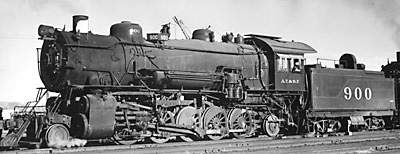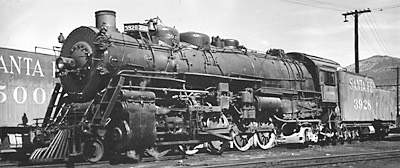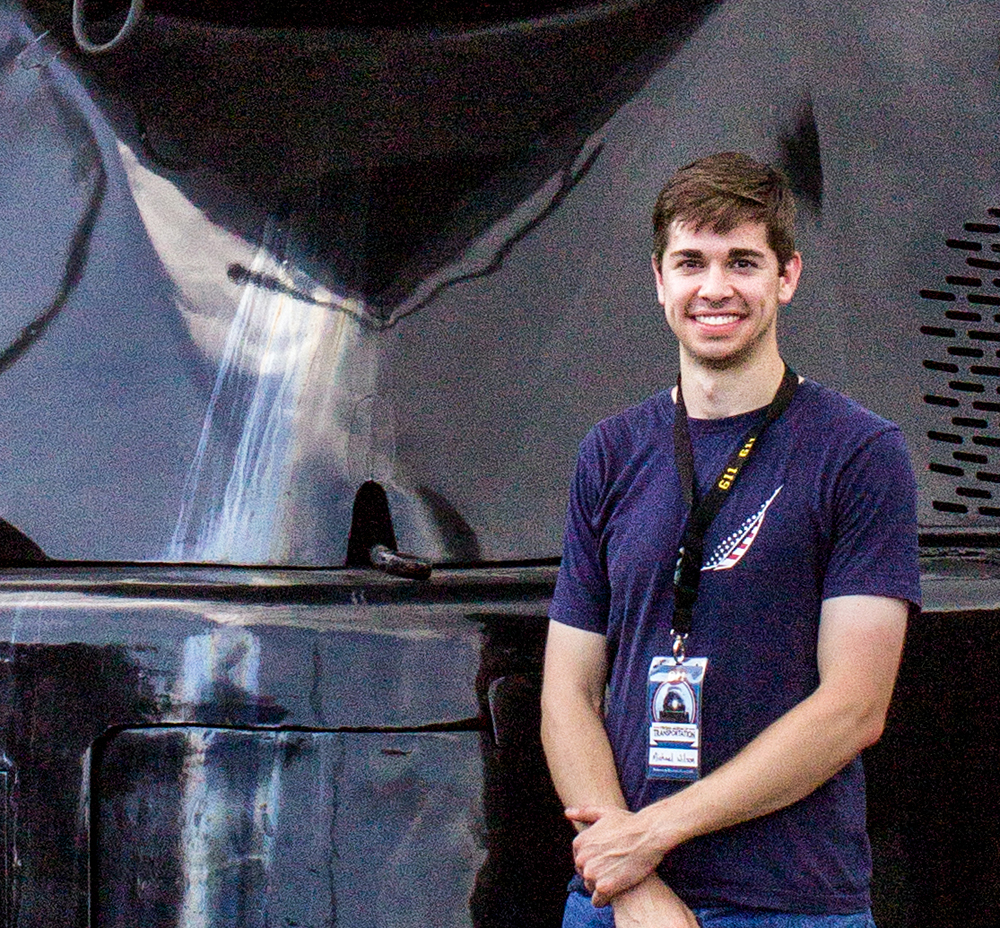By adding a trailing truck, however, a deeper firebox could be placed behind the rear driving wheels, which in turn would increase the engine’s boiler capacity.
The first 2-10-2s were built by Baldwin in 1903 for the Santa Fe, which actually needed the trailing truck to back its helper engines down the twisting alignment of Raton Pass. These early engines were little more than 2-10-0 boilers mounted on a 2-10-2 frame.
Subsequent 2-10-2s had vastly improved boilers, and with the introduction of trailing trucks incorporating outside bearings, it became possible to fully support a wide and deep firebox. The resulting 2-10-2 design had both better riding stability, thanks to centering devices in the trailing truck, and a boiler of greatly increased capacity.
The 2-10-2 was called the Santa Fe type, named after the railroad that developed the engine. With 342 examples on the roster, Santa Fe owned more 2-10-2s than anyone else.
The 2-10-2 quickly gained popularity. Large numbers were built beginning in 1915, and they were used extensively in heavy freight service.
At the time, it was common practice for railroads to assemble as many cars as possible into slow, heavy drag freights, which maximized the locomotive’s pulling power. For this, a Santa Fe fit the bill. With its great adhesion, it could move a bigger train than other non-articulated locomotives of the time. Not surprisingly, it became a popular engine with railroad operating departments.
The wheel arrangement also benefited from subsequent advancements in locomotive technology. The Santa Fe was quickly fitted with superheaters, stokers, axle lateral motion devices, and other improvements. Light and heavy versions of the 2-10-2 were designed by the United States Railroad Administration for use during World War I.
The 2-10-2 was used extensively in the mountains, and railroads such as Erie, Frisco, Southern Pacific, Union Pacific, and Baltimore & Ohio acquired sizeable fleets. As a drag engine, it could also haul long trains across level terrain, and in this capacity it found favor with flatter roads such as Illinois Central and Atlantic Coast Line.
Nevertheless, their popularity was short-lived. While the 2-10-2 had a better boiler than the 2-10-0, it was still a low-speed engine plagued by high maintenance costs.
The reciprocating masses of its big pistons and heavy main rods could not be effectively counterbalanced, and the magnitude of the problem increased with its speed (particularly above 30 mph). Also, there was just not enough room on a 63-inch driver – the largest in use on a Santa Fe – to hold the needed counterweight. As a result, the locomotive frames became misaligned and track was damaged.
As the locomotives began to accumulate excessive shop time, the railroads’ ardor for the 2-10-2 quickly cooled.
The last 2-10-2s were built by Baldwin, delivered to the Reading in 1931.
Overall, about 2,200 were built.
The problems inherent in the Santa Fe were eventually resolved with the 2-10-4 and modern articulated locomotives. These engines began to replace the 2-10-2 in main-line service during the 1920s. Thereafter, the Santa Fe began to fill niche roles in pusher service or as the motive power on coal and ore drags.
Several railroads used the boilers from surplus 2-10-2s to create new dual service 4-8-2s that were better suited to their needs. The diesel, of course, was ideally suited for the same assignments as the 2-10-2, and when it arrived, the Santa Fe type was hard hit.
The last 2-10-2 to operate pulled an excursion train on the Duluth, Missabe & Iron Range in 1962.















